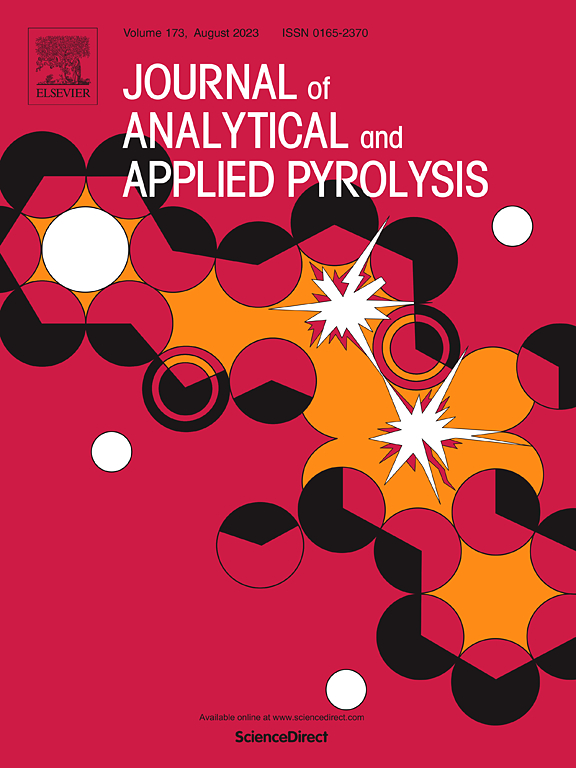TG-FTIR investigations of the pyrolysis of polyurethanes: Quantitative carbon dioxide tracing, decomposition mechanisms, products and mass balances for advanced recycling
IF 5.8
2区 化学
Q1 CHEMISTRY, ANALYTICAL
引用次数: 0
Abstract
Polyurethanes (PUR) are versatile polymers used in a broad range of applications. Conventional mechanical recycling is thus difficult. Chemical recycling such as pyrolytic waste treatment presents new recycling options. Advanced recycling by pyrolysis may help to reduce environmental impacts from PUR wastes. The knowledge of mechanisms, products and yields is essential for the design of efficient pyrolysis processes. Rigid (RPUF) and flexible foams (FPUF), a cast elastomer (CE) and a thermoplastic Polyurethane (TPU) have been investigated by thermogravimetry (TG) and FTIR-spectroscopy. Two decomposition steps have been identified. CO2 is mainly released in the first decomposition step between 250 °C and 400 °C. The second decomposition step at temperatures above 400 °C releases polyol fragments and marginal amounts of CO2. Strong feedstock dependency is evident. Quantitative tracing for the CO2 release was developed, validated and applied. This allows the resolution of specific decomposition phenomena, mass balancing and distinguishing potentially valuable volatiles from CO2 and solid residues. CO2 yields are 12.0 mass-% for RPUF, 4.0 mass-% for FPUF, 3.2 mass-% for CE and 5.3 mass-% for TPU. Considering solids and CO2 as losses, recycling potentials were determined which are 74 mass-% for RPUF, 90 mass-% for FPUF, 95 mass% for CE and 93 mass-% for TPU. This facilitates further process development based on polymer-specific data.
聚氨酯热解的TG-FTIR研究:定量二氧化碳追踪,分解机制,产品和先进回收的质量平衡
聚氨酯(PUR)是一种用途广泛的多用途聚合物。因此,传统的机械回收是困难的。化学回收,如热解废物处理提供了新的回收选择。通过热解的先进回收可以帮助减少PUR废物对环境的影响。机制,产品和产量的知识是必不可少的有效的热解过程的设计。用热重法(TG)和红外光谱法(ftir)研究了刚性泡沫(RPUF)和柔性泡沫(FPUF)、铸造弹性体(CE)和热塑性聚氨酯(TPU)。确定了两个分解步骤。CO2主要在250 °C到400 °C之间的第一步分解中释放。第二个分解步骤在400 °C以上的温度下释放多元醇碎片和少量的二氧化碳。很强的原料依赖性是显而易见的。开发、验证并应用了二氧化碳释放的定量追踪。这可以解决特定的分解现象,质量平衡和区分潜在有价值的挥发物从二氧化碳和固体残留物。RPUF的CO2产率为12.0 mass-%, FPUF为4.0 mass-%, CE为3.2 mass-%, TPU为5.3 mass-%。考虑固体和二氧化碳的损失,确定了RPUF的回收潜力为74质量%,FPUF为90质量%,CE为95质量%,TPU为93质量%。这有助于基于聚合物特定数据的进一步工艺开发。
本文章由计算机程序翻译,如有差异,请以英文原文为准。
求助全文
约1分钟内获得全文
求助全文
来源期刊
CiteScore
9.10
自引率
11.70%
发文量
340
审稿时长
44 days
期刊介绍:
The Journal of Analytical and Applied Pyrolysis (JAAP) is devoted to the publication of papers dealing with innovative applications of pyrolysis processes, the characterization of products related to pyrolysis reactions, and investigations of reaction mechanism. To be considered by JAAP, a manuscript should present significant progress in these topics. The novelty must be satisfactorily argued in the cover letter. A manuscript with a cover letter to the editor not addressing the novelty is likely to be rejected without review.

 求助内容:
求助内容: 应助结果提醒方式:
应助结果提醒方式:


